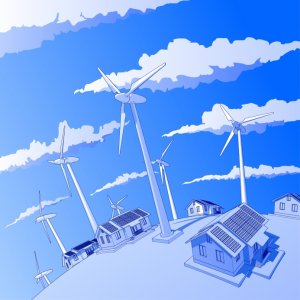Chicago, IL (PRWEB) -- The Midwest Energy Efficiency Alliance (MEEA) released its Midwest Residential Market Assessment today, an important study that documents current residential energy usage and potential energy savings realized by implementing energy efficiency measures. The purpose of the study was to:

"An important study by the MEEA, documents current residential energy usage and potential energy savings realized by implementing simple energy efficiency measures. The study concludes that consumers can save billions while helping the environment."
- Characterize the Midwest residential market, including estimating saturation rates for existing energy efficiency technologies, products, practices, and behavior.
- Evaluate efficiency opportunities in the market.
- Estimate a baseline to assess future residential programs to help consumers further reduce their energy demand.
The study covered nine Mid-western states including Illinois, Indiana, Iowa, Kentucky, Michigan, Minnesota, Missouri, Ohio, and Wisconsin.
"The Market Assessment is a valuable tool. It documents the progress Midwest consumers have made in saving energy, and therefore their hard-earned dollars," said Wendy Jaehn, Executive Director of MEEA. "While we are pleased with the results, significant opportunities remain for consumers to reduce energy usage and lower their bills by taking a few simple measures."
The Midwest Residential Market Assessment documents several areas of improvement we all can easily make to increase energy efficiency and reduce our energy bills. The full Midwest Residential Market Assessment is available via PDF download at www.mwalliance.org. Here are some highlights:
- Insulation
Approximately 5-15% of customers have uninsulated ceilings or walls in their homes. Without insulation, the walls of a house would be very hot to the touch during the summer and an air conditioner must work harder to keep you cool. In the winter, a lack of insulation makes walls very cold to the touch and the furnace must work harder to keep customers warm. Adding the proper installation is one of the most cost-effective measures consumers can take to save energy all year round.
- Windows
Generally between 20-36% of homes have single-paned windows. High-performance windows not only provide reduced annual heating and cooling bills; they reduce the peak heating and cooling loads as well. This has benefits for the homeowner, in that the size of the heating or cooling system may be reduced, further saving the consumer energy.
- Compact Fluorescent Lamps
Less than half of the homes in any Midwest state have one or more compact fluorescent lamps (CFLs). The median percentage of homes with one or more CFLs is 33%. Energy-efficient, ENERGY STAR® qualified lighting provides bright, warm light while it requires 2/3 less energy than standard lighting, generates 70% less heat, and lasts up to 10 times longer.
- Gas Furnaces
The market shares of efficient gas space heating systems are estimated to be the highest in Iowa, Minnesota, and Wisconsin at 74%, 67%, and 50% respectively. For Indiana, Kentucky, Michigan, Missouri, and Ohio, energy auditors estimate the shares of more efficient gas furnaces at 23% on average. ENERGY STAR® qualified furnaces have an annual fuel utilization efficiency (AFUE) rating of 90% or greater, making them about 15% more efficient than standard models.
- Central Air Conditioners
Only 24% of Midwest central air conditioning systems are energy efficient. The federal standard for central air conditioners increased in January 2006 but consumers should look for certified installers in order to realize the energy savings of purchasing efficient systems.
- Water Heaters
Midwest electric and gas water heaters are mainly minimum efficiency units. As an example, energy auditors examined water heaters on-site in Minnesota and concluded that only 1% of water heaters met ENERGY STAR® standards. You can reduce your water heating costs by simply lowering the thermostat setting on your water heater. For each 10°F reduction in water temperature, you can save between 3 to 5% in energy costs. Although some manufacturers set water heater thermostats at 140°F, most households usually only require them set at 120°F or even 115°F. Water heated at 140°F also poses a safety hazard from scalding.
- Appliances
The saturations of ENERGY STAR® appliances in the Midwest are low, ranging between 3% and 6% depending on the appliance. When buying an appliance, consumers need to remember that it has two price tags: what consumers pay to take it home and what consumers pay for the energy and water it uses. ENERGY STAR® qualified appliances incorporate advanced technologies that use 10-50% less energy and water than standard models. Simple actions can make a big difference. If just one in 10 homes used ENERGY STAR® qualified appliances, the change would be the equivalent of planting 1.7 million new acres of trees.
- Programmable Thermostats
The saturation of programmable thermostats varies widely from state to state in the Midwest. On average only 29% of homes have programmable thermostats. Programmable thermostats offer numerous benefits including increased convenience and accuracy over manual thermostats and improve a home's comfort; contain no mercury; save energy and save money on utility bills when used properly, about $100/year.
"Again, making simple, common sense changes can yield huge dividends for the checkbook and the environment at the same time," said Ms. Jaehn. "With energy prices skyrocketing, consumers are looking for ways to save energy and money. Energy issues tend to focus on high gas prices or periodic high electricity or natural gas prices. There are real and ongoing savings to be had at home which will help consumers save money and give them some control of where their dollars are going. And thanks to tax credits, manufacturer rebates, numerous initiatives from national and state governments, coupled with utility-sponsored programs citizens have saved millions and can save billions more."
MEEA gratefully acknowledges Xcel Energy of Minneapolis, Minnesota for sponsoring the study.
MEEA is a leader in increasing and sustaining the level of energy efficiency in the Midwest region by fostering increased market penetration of existing energy-efficient technologies and promoting new technologies, products and best practices, including renewable energy.
For more information, please contact Wendy Jaehn at 312-587-8390 ext. 13

